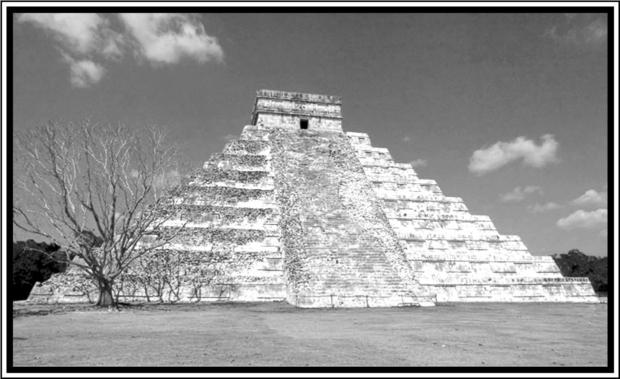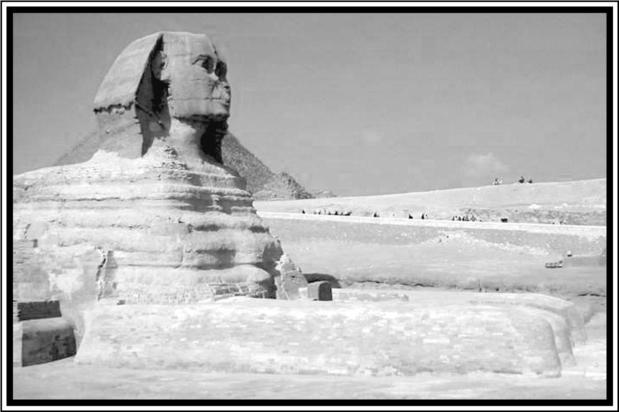Hidden History: Lost Civilizations, Secret Knowledge, and Ancient Mysteries (9 page)
Read Hidden History: Lost Civilizations, Secret Knowledge, and Ancient Mysteries Online
Authors: Brian Haughton
Tags: #Fringe Science, #Gnostic Dementia, #U.S.A., #Alternative History, #Amazon.com, #Retail, #Archaeology, #History

Chichen Itza is generally thought
to have been founded in A.D. 514 by the
priest Lakin Chan, also known as
Itzamna, and at its height comprised
several hundred buildings. The ruins
of the city can be divided into two
groups, one belonging to the Classic Maya period (A.D. 250-900) and constructed between the seventh and 10th
centuries A.D., and the other belonging
to the Maya-Toltec period, which
lasted from the late 10th century up
to the beginning of the 13th century.
The Toltecs, another Native American
people probably originating in central
Mexico, made Chichen Itza their capital in the late 10th century A.D., though
whether this was by force or by some
kind of agreement with the Maya is
not known. It was during the MayaToltec period of the site that Chichen
Itza's most spectacular ruins were
constructed.
The structure that people most
identify with the Mayans and Chichen
Itza is probably the giant stepped
pyramid that dominates the site,
called the Temple of Kukulcan and also
known by its Spanish name of El
Castillo. The temple is actually composed of two buildings, a larger, more
grand pyramid built over an earlier,
more modest structure. The whole
building is around 180 feet tall and
each of its four sides once had 91 steps,
which, in addition to the platform
crowning the structure, makes 365
steps, one for each day of the year.
Further evidence for the calendrical
significance of the temple are its 52
panels (representing the 52-year cycle
of the Mayan calendar round), and 18
terraces (for the 18 months in the
Mayan religious year). The pyramid is
also oriented to accurately mark the
occurrences of the equinoxes. Inside
the earlier of the two pyramid-temples
there are narrow steps leading to a
secret chamber at the top of the structure, where archaeologists discovered
the stone-carved Throne of the Jaguar,
painted in brilliant red with jade
spots, and also a sculpture of a Chac
Mool figure. This latter object is a type
of stone altar consisting of a reclining
figure holding a bowl or tray over its
stomach. It is thought that this tray
was used for offerings of incense to the
figure, who would act as a messenger
to the gods. The bowl may also have
been used to hold human hearts cut
from sacrificial victims. During the
spring or autumn equinox (March 21st and September 21st) when the sun's
light hits the steps on the northern
side of the pyramid, it creates the spectacular illusion of the shadow of a moving serpent slithering up the pyramid
as the sun moves across the sky.

Photograph by Aaron Logan (Creative Commons License. AttributionShareAlike 1.0)
El Castillo (the Castle) at Chichen Itza.
East of El Castillo stands the
Templo de los Guerreros or Temple of
the Warriors, a huge, flat-topped,
pyramidal structure, which originally
possessed a wood and plaster roof. The
temple has pillars sculpted in basrelief in the likeness of warriors, many
of which still retain some of their original color. Surrounding the temple are
hundreds of columns, the remains of
ruined buildings known as the Group
of a Thousand Columns.
On the western side of the site is
The Temple of the Jaguars. This structure derives its name from the procession of jaguars carved on the front of
the upper part of the building, and
was constructed in the Maya Toltec architectural style from around A.D. 900
to 1100. Inside the temple are some of
the most fascinating mural paintings
in Chichen Itza, including one example
which depicts an ancient battle between the Mayas and the Toltecs. Adjacent to the Temple of the Jaguars is
the Ball Court Complex (Juego de
Pelota), one of seven courts for playing
the Meso-American ballgame discovered at Chichen Itza. The dimensions
of this particular court, however, are
544 by 223 feet, making it the largest
ball court ever built in central America,
as well as the best preserved. No one
is quite sure how this ballgame, called
Pok-Ta-Pok by the Maya, was played,
though it was probably more of a
ritual ceremony than a recreational
game. Consensus of opinion is that in
order for a team to score, one of their
players had to pass a firm leather or
rubber ball through the openings of the
stone scoring rings, located on opposite walls of the court, without using
his hands or feet. This could be a
deadly pastime, as it is believed that
the captain of either the winning or
losing team (researchers are not quite
sure) was decapitated at the end of the
game as an offering to the gods. However, the size of this particular ball
court at Chichen Itza has persuaded a
number of scholars that actually playing the game there would have been
out of the question. Due to the enormous size of the court it would not
have been possible for a player to hit
the ball from one end to the other, and
as the stone rings are located almost
20 feet up on the vertical walls, they
would have been completely out of
reach for the players.
One hypothesis which has been
put forward is that the ball court area
was utilized as a ritual space where
ceremonies were performed, which
carried a similar meaning to the actual ball game. Panels along the side
walls of the ball court are decorated
with events from ball games, including scenes of players dressed in heavy
padding and a particularly gruesome
illustration depicting the beheading of
a player in front of both teams. Much
of the Mayan creation story (the
Popol Vuh) is concerned with a ball
game played in this world and also in
the world of the dead, indicating the
religious significance of the game. In
one part of the myth, the hero twins
play the game for their lives against
the lords of the underworld. In another, the use of a ball comprised of a
decapitated head encased in rubber is
described.
More graphic illustrations of the
relevance of the human head in Mayan
ritual is provided by the Tzompantli,
or the Wall of Skulls, a large, centrallylocated T-shaped stone platform 198
feet long and 40 feet wide. This structure was used as a base for wooden
stakes on which the decapitated heads
of enemy warriors and sacrificial victims were impaled for public viewing.
Its walls are covered in bas-relief
sculptures of skulls, as well as carvings of eagles, feathered serpents, and
Mayan warriors carrying human
heads. This Wall of Skulls was probably designed to display the strength
of the Maya and must have presented
a fearsome site to invading armies.
In the southern part of the city
stands one of the highest accomplishments of Mayan architects at Chichen
Itza. This is the 74 foot high Observatory, or El Caracol (the Spanish word
for snail, referring to the resemblance
of the building's internal spiral stairway to a snail's shell). The Observatory, as it stands today, is actually the
ruins of a cylindrical structure, and
consists of a tower built on top of a
rectangular platform. The building
has openings at several points, which
probably served as small windows to
enable the observing and tracking of
stars and planets. South of El Caracol
is the Nunnery, also known by its
Spanish name of Las Monjas, a colossal structure measuring at its base 230
by 115 feet with a height of 59 feet. This
elaborately decorated building was
constructed over a period of several
centuries, but functioned as the city's
government palace.
It is recorded in the Mayan
Chronicles that in A.D. 1221 the Maya
revolted against the Maya-Toltec lords
then ruling at Chichen Itza. Evidence
of destruction has been found by archaeologists in the form of the burning of the Great Market and the
Temple of the Warriors. Civil war subsequently broke out, and control of
Yucatan moved to Mayapan, 30 miles
southeast of Merida. The city of
Mayapan became the most important
center of the Mayan civilization before
the arrival of the Spanish in 1519.
After this shift of power in the early
13th century, Chichen Itza went into
decline, its citizens moving elsewhere,
and when the Spanish came upon the
site in 1517 they found only a city of
ghosts, its past glories long vanished.


Photograph by Michael Reeve. (GNU Free Documentation License.)
The Great Sphinx at Giza.
The purpose of the Sphinx had now
become a little plainer. The Egyptian
Atlanteans had built it as their
grandest statue, their sublimest
figure of remembrance, and they had
dedicated it to their Light-god, the
Sun.
-Paul Brunton
A knoll of rock, which had been left
by the builders of the Great Pyramid
when quarrying stone for its inner
core, was fashioned in the time of
Chepren (Cheops) into a huge
recumbent lion with a human head...
-I.E.S. Edwards
These quotes illustrate the contrasting interpretations of the Great
Sphinx: the wildly mystical with the
coldly pragmatic. Buried for most of
its life in the sand, an air of mystery
has always surrounded the enigmatic
Sphinx, causing speculation about its
age and purpose, method of construction, concealed chambers, role in
prophesy, and relationship to the
equally mysterious pyramids. Much of
this theorizing is to the despair of
Egyptologists and archaeologists, who
alone seek to own the Sphinx and lay
claim to its secrets. Perhaps the primary role of this national symbol of
ancient and modern Egypt, which
stands guard over the Giza plateau, is
as it has always been: to stir the imagination of poets, scholars, mystics, adventurers and tourists for century
after century. The Sphinx of Giza represents the essence of Egypt.
Facing the rising sun, the Great
Sphinx is located on the Giza plateau,
about 6 miles west of Cairo, on the west
bank of the Nile River. Egyptian rulers worshipped it as an aspect of the
Sun God, calling it Hor-Em-Akhet
(Horus of the Horizon). The Sphinx sits
in part of the necropolis of ancient
Memphis, the seat of power for the
pharaohs, a short distance from three
large pyramids-the Great Pyramid of
Khufu (Cheops), Khafre (Chephren),
and Menkaura (Mycerinus). The monument is the largest surviving sculpture
from the ancient world, measuring 241
feet in length and in parts 65 feet in
height. Part of the uraeus (a sacred
cobra that protected from evil forces),
the nose, and the ritual beard are missing; the beard is now displayed in the
British Museum. The extensions at the
side of the head are part of the royal
headcloth. Although the head of the
Sphinx has been badly affected by thousands of years of erosion, traces of the
original paint can still be seen near
one ear. It is thought that originally
the Sphinx's face was painted dark
red. A small temple between its paws
contained dozens of inscribed stelae,
placed there by the pharaohs in honor
of the Sun God.
The Sphinx has suffered greatly
from the ravages of time, man, and
modern pollution. In fact, the only
thing that has saved it from complete
destruction is that it has been submerged beneath the desert sand for
most of its life. There have been various attempts at restoration over the
millennia, beginning in c. 1400 B.c.with
the pharaoh Tuthmosis IV. After falling asleep in the shade of the Sphinx
when out hunting, the pharaoh
dreamt that the great beast was choking from the sand engulfing it, and
that it told him if he cleared the sand
he would obtain the crown of Upper
and Lower Egypt. In between the
front paws of the Sphinx is a granite
stela, now called the Dream Stela,
which is inscribed with the story of
the pharaoh's dream.
